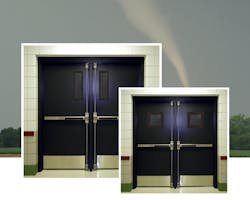Approximately 1,200 tornadoes hit the U.S. annually, according to the NOAA National Severe Storms Laboratory. They’re in the news frequently, especially during the spring and summer. They’re also typically the most sudden, intense, and destructive storms, packing winds that can reach up to 250 mph at their severest. A derecho is another powerful windstorm. Although less frequent, they can do considerable damage when they strike areas along the “Corn Belt” and from the southern Plains to the mid-Mississippi Valley.
Right now, it’s the Atlantic hurricane season. These storms tend to form close to the U.S., particularly in the Gulf of Mexico, the western Caribbean Sea, and near the Southeast and mid-Atlantic coasts. This puts Gulf and Southeast states in the path of sustained winds that can climb to 200 mph. Think of Hurricane Ian, which made landfall in Florida last September. That Category 5 Atlantic hurricane was the deadliest one to strike Florida since 1935 and the third costliest on record.
How one town stepped up
The innovative town of Babcock Ranch, Fla., just inland from Fort Myers, was forward-thinking enough to build homes that could withstand Ian’s hurricane-force winds. Nearly all its 5,000 residents were able to stay put and experienced only very minor damage. It was also providential that only a month before the hurricane, the community had completed a designated hurricane storm shelter that met the International Code Council’s strict ICC 500 standard. Up until then, that part of Florida lacked such a place of refuge.
Most of the time, the structure serves as the Babcock School system’s fieldhouse that features gymnasiums, a cafeteria, locker rooms, and shower facilities. But as the hurricane approached, it quickly shifted into storm shelter mode and ended up comfortably housing 1300-plus people (and hundreds of pets) whose homes in nearby communities suffered severe damage.
Storm shelters are relatively new
It's interesting to note that we’re still in the very early stages of designing and building ICC 500-rated storm shelters in the U.S. Unlike fire codes that were first drafted nearly 140 years ago and have evolved ever since, code requirements for designated storm shelters have only been around since 2008. In other words, it’s a fairly new standard.
For many architects, it’s often a whole new design and learning experience when a storm shelter project lands on their drafting tables. For locksmiths, it’s a fresh opportunity to become an expert on ICC 500-certified opening solutions and why a door, frame, and its hardware come as a complete certified assembly. It’s also a chance to become a go-to installation professional in hurricane country where an increasing number of these hardened structures are being planned.
Earlier, we mentioned how the houses in the Babcock Ranch community were built to withstand the brunt of hurricane force winds. The standards for typical residential and commercial structures in coastal hurricane regions fall under specific state windstorm codes that, while rigorous, are not as stringent and defined as those for ICC 500.
For those building a house, store, or office building in Florida, along the coast of the Carolinas, or even up to Maine where high winds speeds are common, codes dictate that windows and doors must be impact protected. One way is to secure ¾” plywood over openings before the storm hits. But most people in those areas opt for installing doors and windows approved for hurricane impact and that are performance-rated for winds up to 150 mph. ASSA ABLOY offers many code-compliant products in this category.
A designated storm shelter, however, must comply with the stricter, more complex ICC 500 requirements. Some might think, “Well, that Florida-approved hurricane door we used for storefronts should work just fine for the new storm shelter we’re designing.” Not so.
For most coastal hurricane applications, the concern is making sure doors, frames, and hardware don’t create an opening that allows wind to get in and double the pressure on a building. But for life safety, storm shelter products must be designed, manufactured, and tested with much heavier gauge materials and hardware that can withstand impact energy that is 14 times greater than the typical coastal hurricane impact energy.
What ICC says
ICC’s International Building Code (IBC) states that all designated storm shelters must be built according to ICC 500. ICC Section 423 says it “applies to the construction of storm shelters constructed as separate detached buildings or constructed as rooms or spaces within buildings for the purpose of providing protection from storms that produce high winds, such as tornadoes and hurricanes. Such structures shall be designated to be hurricane shelters, tornado shelters, or combined hurricane and tornado shelters.”
Since 2015, the code also requires the construction of tornado storm shelters in all new schools, new additions to existing schools, and first response centers in the 23 states within the red wind zones on the ICC 500 map.
However, Michigan, Ohio, and Oklahoma have chosen to push out storm shelter requirements for K-12 schools to the states’ code annexes, which means that schools have the option of adding one or not, but it’s no longer a requirement.
Storm shelter door opening solutions
ASSA ABLOY is the leader in the industry for storm shelter doors, door frames, and door hardware (provided as a complete system) and has third-party certifications that show compliance with ICC 500-2020 standards as referenced in the latest building code.
The company is also a product leader in the more common coastal hurricane applications category with one of the largest portfolios of product offerings, including commercial steel doors that meet Florida Building Code (FBC) approval. A wide variety of hardware, decorative, and performance options are available as well, depending on structural pressures that architects are trying to meet.
The range of storm shelter door solutions is more limited, which is logical since the focus for shelter doors and hardware is on heavy-duty protection and life safety. Even so, aesthetics are always part of the design and an important factor.
At the Babcock Ranch Fieldhouse/Storm Shelter, architects chose Ceco StormPro® FEMA door assemblies utilizing SARGENT hardware for the 16 sets of double and single doors in the building. Ceco and Curries StormPro Systems include ICC 500 tested and certified cold rolled steel doors in 16, 14, and 12-gauge face skin options, frames in 16, 14, and 12-gauge options, a 1-3/4” door thickness, multi-point locks including exit devices, and the ability to add narrow light 4” x 25” factory-installed fire-rated StormPro glazing, among other features.
Storm shelter locking hardware includes Corbin Russwin FE6600 Series and SARGENT FM7300 Series multi-point mortise locks, engineered to provide a full range of mechanical and electromechanical functions. Corbin Russwin FE5400S Series and SARGENT FM8700 Series exit devices are also available and come with specially machined rails and internal components to make them sturdier and more robust.
Many of these products are approved for access control solutions, which are needed for most installations. Codes will require whether access control devices need to be fail-safe or fail-secure, depending on the opening. For storm shelters, door hardware needs to be fail-secure in order to ensure the door remains locked if power goes out.
ASSA ABLOY Group brands Markar and McKinney also offer a selection of hinges and other accessories that meet storm shelter requirements.
Great opportunities are there for designers and builders interested in being part of the vital storm shelter construction community. The key to success is learning and understanding the importance of storm shelter requirements and codes, adhering to them, and working together with the inspectors enforcing and monitoring them.
Here’s the best place for more information about storm shelters, ICC 500, and tornado/hurricane-resistant opening protective products: https://www.assaabloydss.com/en/solutions/solutions-by-challenge/threat-protection/weather-resistant






